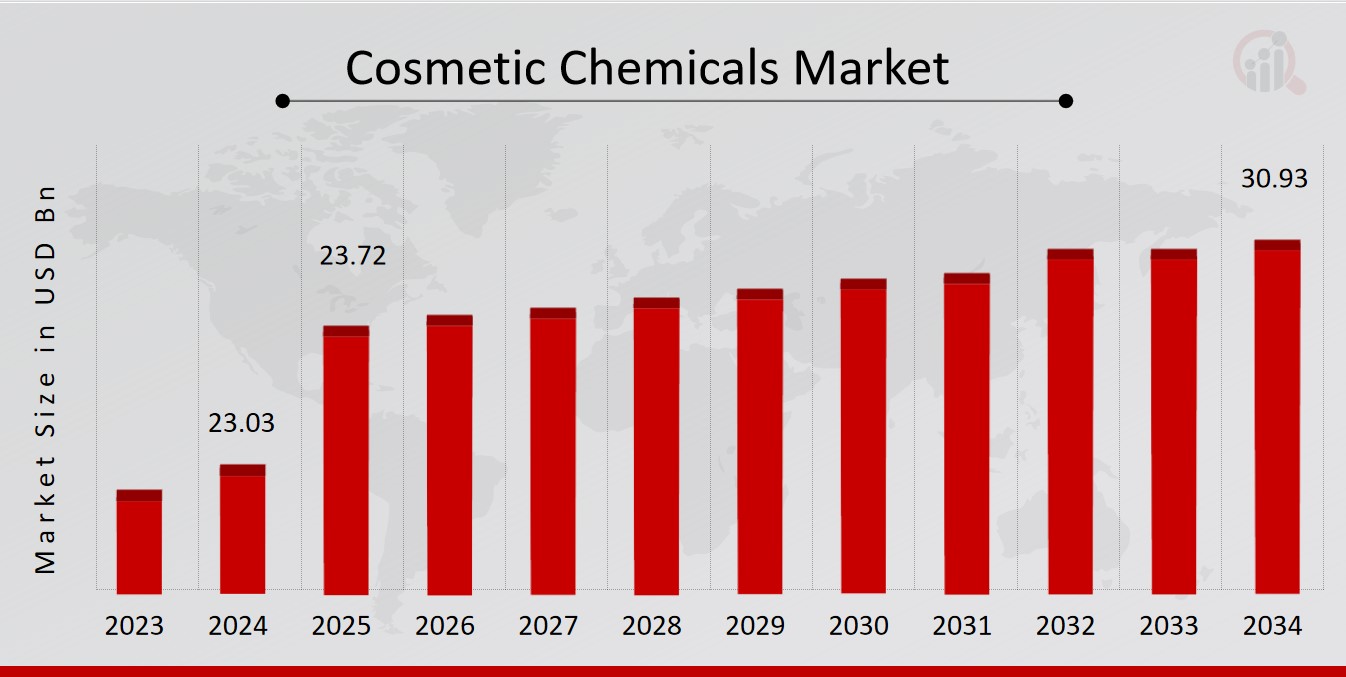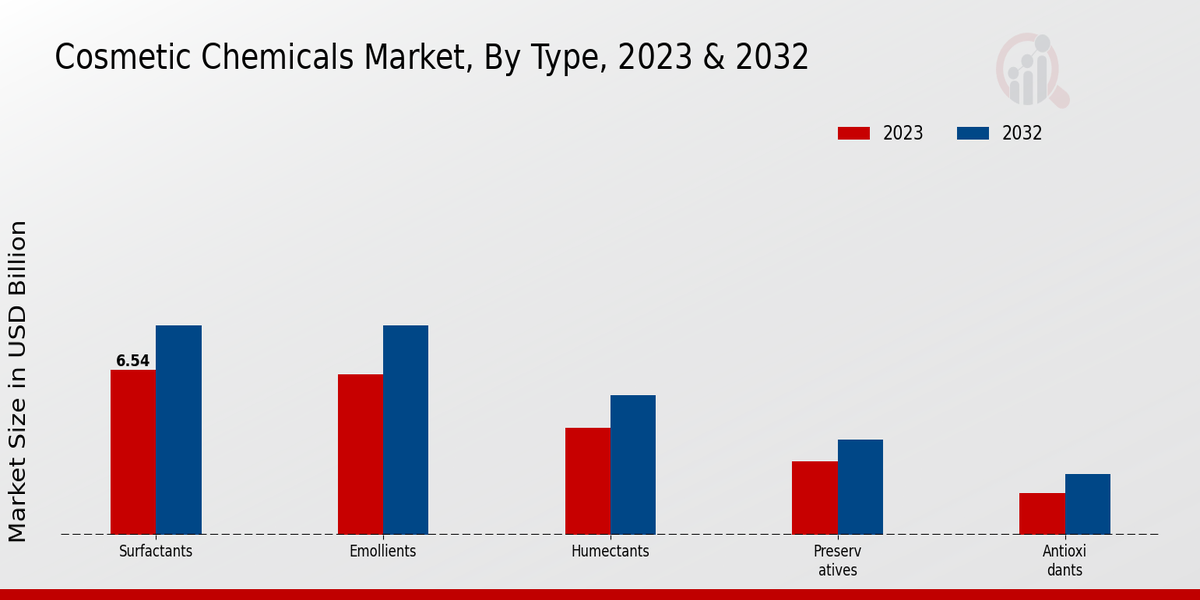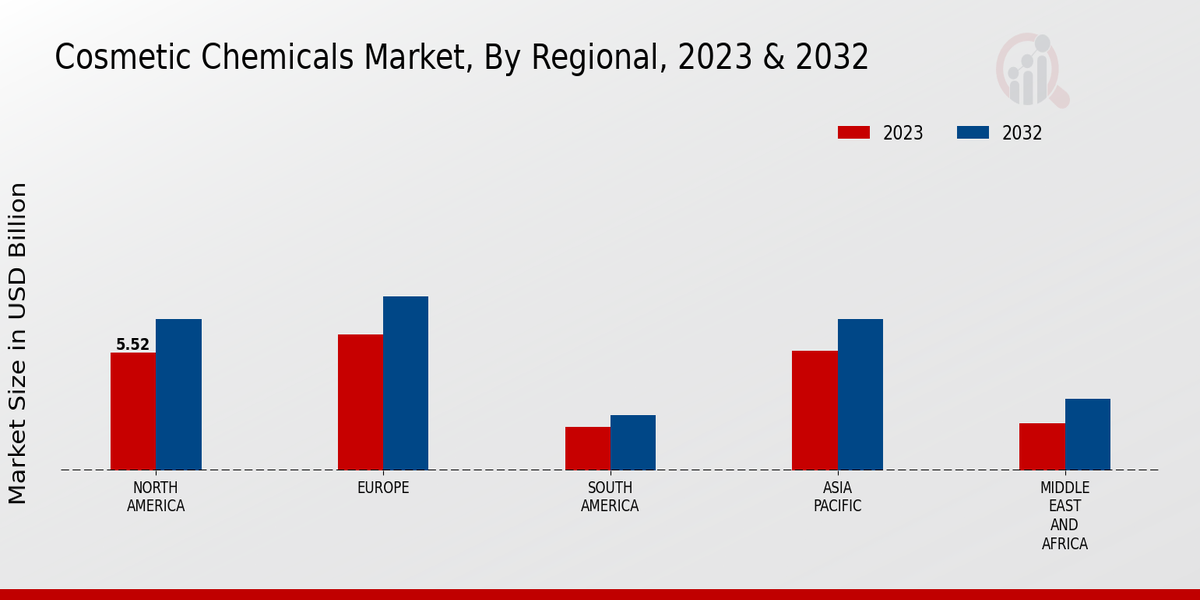Global Cosmetic Chemicals Market Overview
The Cosmetic Chemicals Market Size was estimated at 23.03 (USD Billion) in 2024. The Cosmetic Chemicals Industry is expected to grow from 23.72 (USD Billion) in 2025 to 30.93 (USD Billion) by 2034. The Cosmetic Chemicals Market CAGR (growth rate) is expected to be around 2.99% during the forecast period (2025 - 2034).
Key Cosmetic Chemicals Market Trends Highlighted
The formulas used in cosmetic chemicals are always being improved upon to satisfy changing consumer needs. The growing popularity of natural and organic ingredients, rising disposable incomes, and expanding concern of personal hygiene and appearance are important market drivers.
In addition, the growing cosmetics market in emerging nations and the rising demand for skin-lightening and anti-aging treatments offer substantial development prospects.
Current developments in the cosmetic chemicals industry include the use of environmentally friendly and sustainable processes, the integration of cutting-edge technologies like biotechnology and nanotechnology, and the personalization of goods to cater to the demands of individual customers.
Furthermore, new channels for firms to connect customers and advertise their goods have been made possible by the expanding importance of social media and online purchasing.
Market players can seize development opportunities and obtain a competitive edge in the ever-changing landscape of cosmetic chemicals by capitalizing on these trends and meeting the changing wants of customers.

Source: Primary Research, Secondary Research, Market Research Future Database and Analyst Review
Cosmetic Chemicals Market Drivers
-
Rising Demand for Natural and Organic Cosmetic Products
Consumer awareness regarding cosmetic products is growing thanks to chemical composition. Therefore, there is an increase in the demand for cosmetics which will not harm health and the environment.
Organic and natural cosmetics are making advances in the world market as it is a much healthier variety for the skin. In this regard, in the coming years, the natural and organic cosmetic sector will be boosted because consumers will learn more about the negative effects of chemicals used on our skin.
Moreover, according to the market forecast indicated in the Cosmetic Chemicals Market, there will be substantial growth in the demand for natural and organic cosmetic products.
Growth of the Anti-Aging Market
One of the quickest-developing segments of the cosmetic chemicals market is the anti-aging market. In light of the expanding populace, there is an expanding interest in items that are utilized for lessening wrinkles, scarcely discernible differences and other indications of maturing. The pattern will proceed in the coming years.
Increasing Popularity of Cosmetic Procedures
The increasing popularity of cosmetic procedures is also driving the growth of the cosmetic chemicals market. Cosmetic procedures, such as Botox injections and dermal fillers, are becoming increasingly common as people look for ways to improve their appearance.
This trend is expected to continue in the coming years as more and more people are willing to undergo cosmetic procedures.
Cosmetic Chemicals Market Segment Insights
Cosmetic Chemicals Market Type Insights
The Type segment of the Cosmetic Chemicals Market exhibited a significant market valuation of USD 22.35 billion in 2023 and is projected to reach USD 30.24 billion by 2032, advancing at a CAGR of 3.1% during the forecast period (2024-2032).
The growth of this segment can be attributed to the increasing demand for cosmetics and personal care products, coupled with rising consumer awareness regarding skin health and appearance.
Surfactants held the largest market share in 2023, accounting for approximately 35% of the Cosmetic Chemicals Market revenue.
Surfactants are widely used in cosmetic formulations as they help in cleansing, emulsifying, and foaming, making them essential ingredients in products like shampoos, conditioners, and facial cleansers.
Emollients, with a market share of around 28% in 2023, are another important category within the Type segment. Emollients, such as oils and waxes, provide moisturizing and skin-softening properties, making them commonly used in skincare products, body lotions, and lip balms.
Humectants, representing approximately 22% of the market share in 2023, play a crucial role in maintaining skin hydration.
These ingredients, like glycerin and hyaluronic acid, help attract and retain moisture, making them vital in skincare products for dry and sensitive skin types. Preservatives, with a market share of around 10% in 2023, ensure the longevity and safety of cosmetic products by preventing microbial growth.
Parabens and phenoxyethanol are commonly used preservatives that help extend the shelf life of cosmetics. Antioxidants, accounting for approximately 5% of the market share in 2023, protect cosmetic products and the skin from damage caused by free radicals.
Vitamin E and vitamin C are widely used antioxidants in cosmetics, offering anti-aging and skin-protecting benefits.
The market growth for Cosmetic Chemicals is driven by factors such as increasing disposable income, rising consumer spending on personal care products, and growing awareness about skin health and beauty.
Furthermore, advancements in cosmetic chemistry and the introduction of innovative ingredients are expected to contribute to the continued expansion of the Cosmetic Chemicals Market in the coming years.

Source: Primary Research, Secondary Research, Market Research Future Database and Analyst Review
Cosmetic Chemicals Market Application Insights
The application segment of the Cosmetic Chemicals Market is categorized into Skincare, Haircare, Makeup, and Personal Care. Skincare held the largest market share in 2023, accounting for over 40% of the Cosmetic Chemicals Market revenue.
The growing demand for anti-aging, moisturizing, and anti-acne products is driving the growth of this segment. The Haircare segment is projected to witness significant growth over the forecast period, owing to the rising popularity of hair styling and hair care products.
The Makeup segment is also expected to grow steadily, driven by the increasing demand for color cosmetics and makeup products.
The Personal Care segment, which includes products such as deodorant, body wash, and toothpaste, is expected to grow moderately over the forecast period.
Cosmetic Chemicals Market Function Insights
The Function segment is a critical aspect of the Cosmetic Chemicals Market, influencing product development and consumer preferences. Cleansing is a fundamental function, accounting for a notable share of the market.
In 2023, the cleansing function segment was valued at approximately USD 4.2 billion and is projected to reach USD 5.1 billion by 2032. Moisturizing is another key function, with the segment valued at around USD 3.7 billion in 2023 and expected to grow to USD 4.6 billion by 2032.
Exfoliating, Conditioning, and Protecting functions also hold significant shares in the market. The Exfoliating function segment is estimated to be worth USD 2.9 billion in 2023 and is forecasted to reach USD 3.6 billion by 2032.
The Conditioning function segment is valued at approximately USD 3.2 billion in 2023 and is projected to grow to USD 4.0 billion by 2032. The Protecting Function segment is estimated to be worth USD 2.7 billion in 2023 and is forecasted to reach USD 3.4 billion by 2032.
These segments are driven by increasing consumer demand for effective and specialized cosmetic products that address specific skincare needs and concerns.
Cosmetic Chemicals Market Source Insights
The source segment of the Cosmetic Chemicals Market is classified into synthetic, natural, and organic. Among these, the synthetic segment held the largest market share of 62.5% in 2023 and is expected to maintain its dominance throughout the forecast period.
The growth of the synthetic segment can be attributed to the increasing demand for cost-effective and high-performance cosmetic products.
The natural segment is projected to witness a significant CAGR of 4.2% during the forecast period, owing to the rising consumer preference for natural and sustainable cosmetic products.
The organic segment is expected to grow at a steady pace, driven by the increasing awareness about the benefits of organic ingredients and the growing demand for eco-friendly cosmetic products.
Cosmetic Chemicals Market Regional Insights
The Cosmetic Chemicals Market is segmented into North America, Europe, APAC, South America, and MEA. In 2023, North America led the market, accounting for around 40% of the Cosmetic Chemicals Market revenue.
Europe and APAC followed with a market share of approximately 25% and 22%, respectively. South America and MEA held a market share of around 8% and 5%, respectively.
The North American market is driven by the growing demand for natural and organic cosmetics, as well as the presence of major cosmetic manufacturers in the region.
The European market is expected to grow steadily due to the increasing demand for anti-aging and skincare products.
The APAC market is anticipated to witness significant growth over the forecast period, driven by the rising disposable income and the increasing awareness of personal care products in the region.
South America and MEA are expected to grow at a moderate pace due to the growing middle class and the increasing demand for affordable cosmetic products.

Source: Primary Research, Secondary Research, Market Research Future Database and Analyst Review
Cosmetic Chemicals Market Key Players and Competitive Insights
The Cosmetic Chemicals Market is expected to witness considerable development in the coming years. Due to the increasing demand for cosmetics and personal care products, the leading players in the industry are concentrating on developing new products and expanding their production capacities.
Furthermore, to enhance the quality and performance of their products, the leading players in the Cosmetic Chemicals Market are spending money in research and development.
The Competitive Landscape of the Cosmetic Chemicals Market includes a few of the large players and many of the small players.
BASF SE is one of the worldwide suppliers of cosmetic chemicals. The company offers a broad range of products, including surfactants, emollients, and polymers. BASF SE is one of the market leaders in the production of cosmetic chemicals. The product range of the company includes around 1000 products.
BASF SE has a strong focus on innovation. It constantly expands its portfolio and offers around 200 new cosmetic formulations every year. The company is also strongly committed to sustainability.
For example, in 2018, the company was awarded a “Gold” status by EcoVadis for its sustainable procurement program. BASF SE has a presence. It has customers in more than 180 countries.
Clariant AG is another leading player in the Cosmetic Chemicals Market. It offers a broad range of products, including surfactants, specialty chemicals, and pigments.
The company has a strong focus on sustainability. Clariant AG is aimed at reducing their environmental impact and constantly develops new sustainable products. The firm has a presence, and its customers are in more than 100 countries.
Key Companies in the Cosmetic Chemicals Market Include
Cosmetic Chemicals Market Developments
-
Q2 2024: BASF opens new production facility for cosmetic ingredients in Düsseldorf BASF inaugurated a new state-of-the-art production facility in Düsseldorf, Germany, dedicated to manufacturing specialty chemicals for the cosmetics industry, aiming to meet growing demand for sustainable and innovative personal care ingredients.
-
Q2 2024: Croda International acquires Spanish cosmetic ingredients firm Iberchem Croda International announced the acquisition of Iberchem’s cosmetic chemicals division, expanding its portfolio of natural and specialty ingredients for the global beauty and personal care market.
-
Q3 2024: L'Oréal and Clariant announce strategic partnership for green surfactant development L'Oréal entered a multi-year partnership with Clariant to co-develop and commercialize next-generation green surfactants for use in hair and skin care products, focusing on renewable raw materials.
-
Q3 2024: Evonik launches new biodegradable emollient for cosmetic formulations Evonik Industries introduced a new line of biodegradable emollients designed for use in skin and hair care products, targeting the clean beauty segment and responding to regulatory and consumer demand for sustainable ingredients.
-
Q2 2024: Symrise appoints new CEO to drive innovation in cosmetic chemicals Symrise AG named Dr. Anna Müller as its new CEO, with a mandate to accelerate innovation and sustainability initiatives in the company’s cosmetic chemicals division.
-
Q1 2025: DSM-Firmenich opens R&D center for bio-based cosmetic actives in Switzerland DSM-Firmenich inaugurated a new research and development center in Basel focused on the discovery and production of bio-based active ingredients for the cosmetics industry.
-
Q2 2025: Ashland secures multi-year supply contract with major Asian cosmetics brand Ashland signed a multi-year agreement to supply specialty polymers and conditioning agents to a leading Asian cosmetics manufacturer, strengthening its presence in the fast-growing Asia-Pacific market.
-
Q2 2024: Henkel launches vegan-certified hair care ingredient line Henkel introduced a new range of vegan-certified ingredients for hair care formulations, targeting brands seeking plant-based and cruelty-free cosmetic solutions.
-
Q3 2024: Givaudan acquires minority stake in biotech startup developing natural cosmetic preservatives Givaudan invested in a biotechnology startup specializing in natural preservatives for cosmetics, aiming to expand its portfolio of clean label and sustainable ingredients.
-
Q1 2025: Solvay receives EU regulatory approval for new UV filter in sunscreens Solvay obtained European Union regulatory clearance for its latest UV filter ingredient, enabling its use in sunscreen and personal care products across the EU market.
-
Q2 2025: Clariant opens new application laboratory for personal care chemicals in Singapore Clariant inaugurated a new application laboratory in Singapore to support formulation development and technical services for its personal care and cosmetic chemicals customers in Asia.
-
Q2 2024: L'Oréal launches AI-powered platform for rapid cosmetic ingredient safety assessment L'Oréal unveiled an artificial intelligence platform designed to accelerate the safety assessment of new cosmetic ingredients, aiming to reduce time-to-market for innovative formulations.
Cosmetic Chemicals Market Segmentation Insights
Cosmetic Chemicals Market Type Outlook
Cosmetic Chemicals Market Application Outlook
Cosmetic Chemicals Market Function Outlook
Cosmetic Chemicals Market Source Outlook
Cosmetic Chemicals Market Regional Outlook
|
Report Attribute/Metric
|
Details
|
|
Market Size 2024
|
23.03 (USD Billion)
|
|
Market Size 2025
|
23.72 (USD Billion)
|
|
Market Size 2034
|
30.93 (USD Billion)
|
|
Compound Annual Growth Rate (CAGR)
|
2.99% (2025 - 2034)
|
|
Report Coverage
|
Revenue Forecast, Competitive Landscape, Growth Factors, and Trends
|
|
Base Year
|
2024
|
|
Market Forecast Period
|
2025 - 2034
|
|
Historical Data
|
2020 - 2024
|
|
Market Forecast Units
|
USD Billion
|
|
Key Companies Profiled
|
Ashland, Dow, Kao Corporation, L’Oréal, AkzoNobel, Procter Gamble, BASF, Stepan Company, Solvay, Croda International, Unilever, Lonza, Huntsman Corporation, Clariant, Evonik
|
|
Segments Covered
|
Type, Application, Function, Source, Regional
|
|
Key Market Opportunities
|
1 Natural and Sustainable Ingredients
2 Personalized Cosmetics
3 E-commerce Growth
4 Advanced Delivery Systems
|
|
Key Market Dynamics
|
Increasing consumer demand for natural and organic cosmetics
Technological advancements in cosmetic formulations
Growing popularity of e-commerce platforms
Rising disposable incomes in emerging markets
Government regulations on cosmetic safety
|
|
Countries Covered
|
North America, Europe, APAC, South America, MEA
|
Frequently Asked Questions (FAQ):
The Cosmetic Chemicals Market is expected to reach a valuation of USD 23.03 billion in 2024 and is projected to grow at a CAGR of 2.99%, reaching USD 30.93 billion by 2034.
Asia-Pacific is the dominant region in the Cosmetic Chemicals Market, accounting for over 40% of the market share. China and India are the major contributors to the growth in this region. North America and Europe are other significant markets with a strong demand for premium and organic cosmetic products.
Cosmetic Chemicals are primarily used in skincare, haircare, and makeup products. They serve various functions such as cleansing, moisturizing, conditioning, coloring, and protecting the skin and hair. Some common examples include surfactants, emollients, humectants, and pigments.
Key players in the Cosmetic Chemicals Market include BASF, Dow, Evonik, Lonza, Croda International, Ashland, Solvay, Clariant, and Arkema. These companies have a strong presence and offer a wide range of cosmetic chemicals to meet the diverse needs of the industry.
The growth of the Cosmetic Chemicals Market is attributed to factors such as rising disposable income, increasing awareness of personal care and appearance, and the growing popularity of organic and natural cosmetic products. Additionally, advancements in technology and innovation are leading to the development of new and improved cosmetic chemicals that meet consumer demands.
The Cosmetic Chemicals Market faces challenges related to regulatory compliance, environmental concerns, and competition from low-cost producers. Stringent regulations governing the use of certain chemicals in cosmetic products can hinder market growth. Moreover, consumers are becoming more environmentally conscious, leading to a demand for sustainable and eco-friendly cosmetic chemicals.
The Cosmetic Chemicals Market is witnessing emerging trends such as the growing popularity of personalized and customized cosmetic products, the increasing demand for multifunctional ingredients, and the adoption of sustainable and biodegradable chemicals. Additionally, advancements in biotechnology and nanotechnology are expected to create new opportunities for innovation in the cosmetic chemicals industry.
The COVID-19 pandemic had a significant impact on the Cosmetic Chemicals Market, leading to a decline in demand due to lockdowns and disruptions in the supply chain. However, the market is expected to recover as the pandemic subsides and consumer confidence returns.
Growth opportunities for the Cosmetic Chemicals Market lie in the expansion of emerging markets, the development of innovative and sustainable products, and the adoption of digital technologies. Additionally, the growing demand for natural and organic cosmetics presents a significant opportunity for market players.
The outlook for the Cosmetic Chemicals Market is positive, with a projected CAGR of 2.99% from 2025 to 2034. Rising consumer demand for personal care products, coupled with technological advancements and the expansion of emerging markets, is expected to drive market growth in the coming years.

















